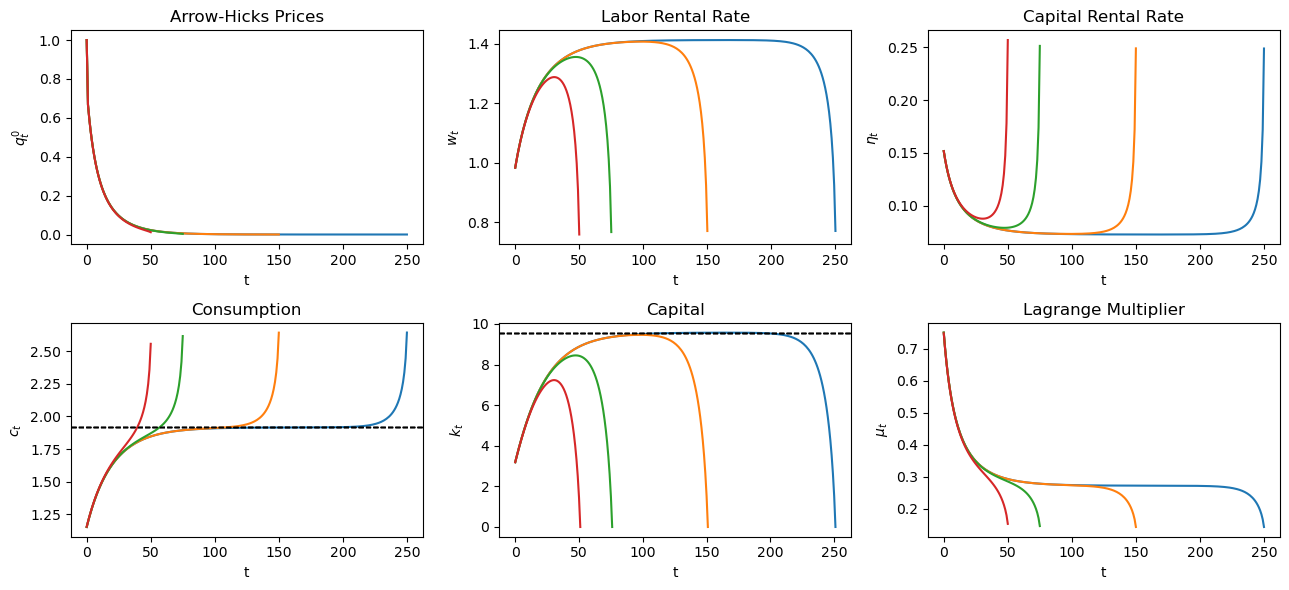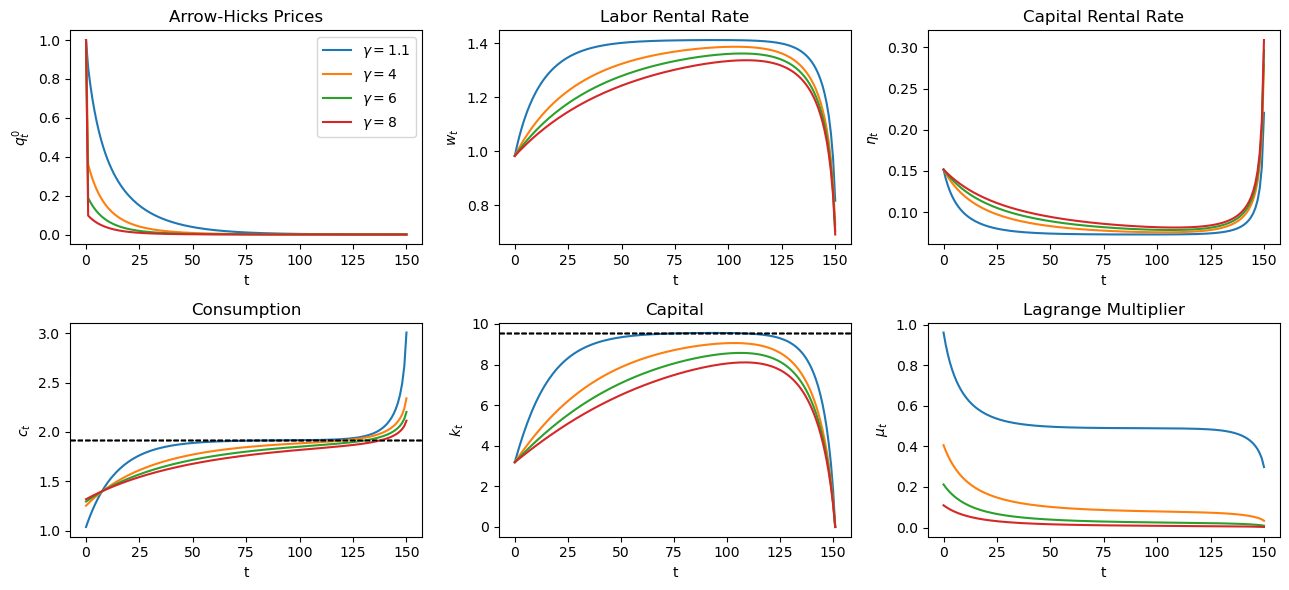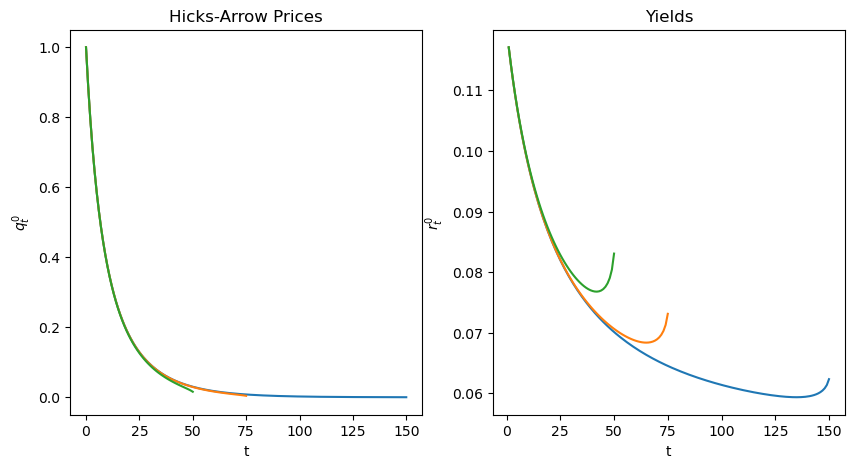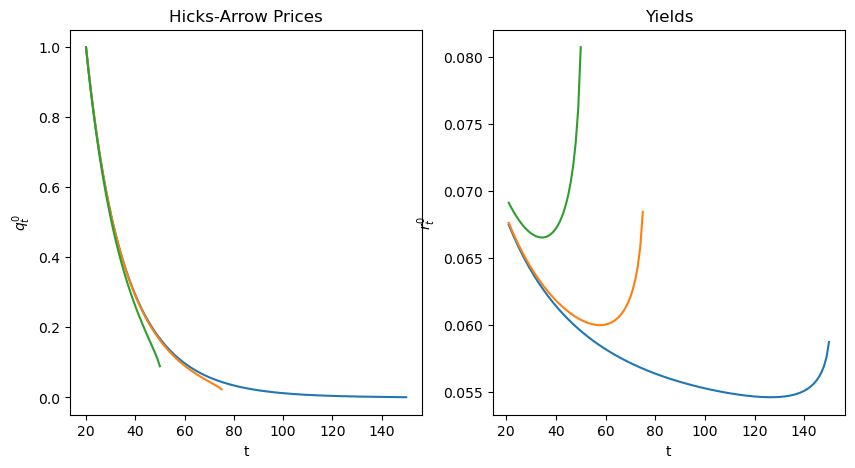47. Cass-Koopmans Competitive Equilibrium#
Contents
47.1. Overview#
This lecture continues our analysis in this lecture Cass-Koopmans Planning Model about the model that Tjalling Koopmans [Koopmans, 1965] and David Cass [Cass, 1965] used to study optimal capital accumulation.
This lecture illustrates what is, in fact, a more general connection between a planned economy and an economy organized as a competitive equilibrium or a market economy.
The earlier lecture Cass-Koopmans Planning Model studied a planning problem and used ideas including
A Lagrangian formulation of the planning problem that leads to a system of difference equations.
A shooting algorithm for solving difference equations subject to initial and terminal conditions.
A turnpike property that describes optimal paths for long-but-finite horizon economies.
The present lecture uses additional ideas including
Hicks-Arrow prices, named after John R. Hicks and Kenneth Arrow.
A connection between some Lagrange multipliers from the planning problem and the Hicks-Arrow prices.
A Big
We shall encounter this trick in this lecture and also in this lecture.
A non-stochastic version of a theory of the term structure of interest rates.
An intimate connection between two ways to organize an economy, namely:
socialism in which a central planner commands the allocation of resources, and
competitive markets in which competitive equilibrium prices induce individual consumers and producers to choose a socially optimal allocation as unintended consequences of their selfish decisions
Let’s start with some standard imports:
import matplotlib.pyplot as plt
plt.rcParams["figure.figsize"] = (11, 5) #set default figure size
from numba import jit, float64
from numba.experimental import jitclass
import numpy as np
47.2. Review of Cass-Koopmans Model#
The physical setting is identical with that in Cass-Koopmans Planning Model.
Time is discrete and takes values
Output of a single good can either be consumed or invested in physical capital.
The capital good is durable but partially depreciates each period at a constant rate.
We let
Let
Let
A representative household is endowed with one unit of labor at each
The representative household inelastically supplies a single unit of
labor
The representative household has preferences over consumption bundles ordered by the utility functional:
where
We assume that
There is an economy-wide production function
with
A feasible allocation
where
47.2.1. Planning Problem#
In this lecture Cass-Koopmans Planning Model, we studied a problem in which a planner chooses an allocation
The allocation that solves the planning problem reappears in a competitive equilibrium, as we shall see below.
47.3. Competitive Equilibrium#
We now study a decentralized version of the economy.
It shares the same technology and preference structure as the planned economy studied in this lecture Cass-Koopmans Planning Model.
But now there is no planner.
There are (unit masses of) price-taking consumers and firms.
Market prices are set to reconcile distinct decisions that are made separately by a representative consumer and a representative firm.
There is a representative consumer who has the same preferences over consumption plans as did a consumer in the planned economy.
Instead of being told what to consume and save by a planner, a consumer (also known as a household) chooses for itself subject to a budget constraint.
At each time
The consumer decides how much income to allocate to consumption or to savings.
The household can save either by acquiring additional physical capital (it trades one for one with time
The household owns physical capital and labor and rents them to the firm.
The household consumes, supplies labor, and invests in physical capital.
A profit-maximizing representative firm operates the production technology.
The firm rents labor and capital each period from the representative household and sells its output each period to the household.
The representative household and the representative firm are both price takers who believe that prices are not affected by their choices
Note
Again, we can think of there being unit measures of identical representative consumers and identical representative firms.
47.4. Market Structure#
The representative household and the representative firm are both price takers.
The household owns both factors of production, namely, labor and physical capital.
Each period, the firm rents both factors from the household.
There is a single grand competitive market in which a
household trades date
47.4.1. Prices#
There are sequences of prices
In addition there is a vector
We call
Because is a relative price. the unit of account in terms of which the prices
Units of
In this case, we would be taking the time
47.5. Firm Problem#
At time
The firm’s profits at time
where
As in the planned economy model
47.5.1. Zero Profit Conditions#
Zero-profits conditions for capital and labor are
and
These conditions emerge from a no-arbitrage requirement.
To describe this no-arbitrage profits reasoning, we begin by applying a theorem of Euler about linearly homogenous functions.
The theorem applies to the Cobb-Douglas production function because we it displays constant returns to scale:
for
Taking partial derivatives
Rewrite the firm’s profits as
or
Because
If
But setting
A similar argument applies if
If
It is convenient to define
47.6. Household Problem#
A representative household lives at
At
At
consumption
net investment
Here
In period
A consumer’s net excess demand for time
Let
The household faces a single budget constraint that requires that the present value of the household’s net excess demands must be zero:
or
The household faces price system
Components of a price system have the following units:
47.6.1. Definitions#
A price system is a sequence
An allocation is a sequence
A competitive equilibrium is a price system and an allocation with the following properties:
Given the price system, the allocation solves the household’s problem.
Given the price system, the allocation solves the firm’s problem.
The vision here is that an equilibrium price system and allocation are determined once and for all.
In effect, we imagine that all trades occur just before time
47.7. Computing a Competitive Equilibrium#
We compute a competitive equilibrium by using a guess and verify approach.
We guess equilibrium price sequences
We then verify that at those prices, the household and the firm choose the same allocation.
47.7.1. Guess for Price System#
In this lecture Cass-Koopmans Planning Model, we computed an allocation
We use that allocation to construct a guess for the equilibrium price system.
Note
This allocation will constitute the Big
In particular, we shall use the following procedure:
obtain first-order conditions for the representative firm and the representative consumer.
from these equations, obtain a new set of equations by replacing the firm’s choice variables
solve the resulting equations for
verify that at these prices,
Thus, we guess that for
At these prices, let capital chosen by the household be
and let the allocation chosen by the firm be
and so on.
If our guess for the equilibrium price system is correct, then it must occur that
We shall verify that for
47.7.2. Verification Procedure#
Our approach is firsts to stare at first-order necessary conditions for optimization problems of the household and the firm.
At the price system we have guessed, we’ll then verify that both sets of first-order conditions are satisfied at the allocation that solves the planning problem.
47.7.3. Household’s Lagrangian#
To solve the household’s problem, we formulate the Lagrangian
and attack the min-max problem:
First-order conditions are
Now we plug in our guesses of prices and do some algebra in the hope of recovering all first-order necessary conditions (46.9)-(46.12) for the planning problem from this lecture Cass-Koopmans Planning Model.
Combining (47.9) and (47.2), we get:
which is (46.9).
Combining (47.10), (47.2), and (47.4), we get:
Rewriting (47.13) by dividing by
or
which is (46.10).
Combining (47.11), (47.2), (47.3)
and (47.4) after multiplying both sides of
(47.11) by
which simplifies to
Since
which is (46.11).
Combining (47.12) and (47.2), we get:
Dividing both sides by
which is (46.12) for the planning problem.
Thus, at our guess of the equilibrium price system, the allocation that solves the planning problem also solves the problem faced by a representative household living in a competitive equilibrium.
47.7.4. Representative Firm’s Problem#
We now turn to the problem faced by a firm in a competitive equilibrium:
If we plug (47.8) into (47.1) for all t, we get
which is (47.4).
If we now plug (47.8) into (47.1) for all t, we get:
which is exactly (47.5).
Thus, at our guess for the equilibrium price system, the allocation that solves the planning problem also solves the problem faced by a firm within a competitive equilibrium.
By (47.6) and (47.7) this allocation is identical to the one that solves the consumer’s problem.
Note
Because budget sets are affected only by relative prices,
Normalization: We are free to choose a
We will plot
To proceed, we bring in Python code that Cass-Koopmans Planning Model used to solve the planning problem
First let’s define a jitclass that stores parameters and functions
the characterize an economy.
planning_data = [
('γ', float64), # Coefficient of relative risk aversion
('β', float64), # Discount factor
('δ', float64), # Depreciation rate on capital
('α', float64), # Return to capital per capita
('A', float64) # Technology
]
@jitclass(planning_data)
class PlanningProblem():
def __init__(self, γ=2, β=0.95, δ=0.02, α=0.33, A=1):
self.γ, self.β = γ, β
self.δ, self.α, self.A = δ, α, A
def u(self, c):
'''
Utility function
ASIDE: If you have a utility function that is hard to solve by hand
you can use automatic or symbolic differentiation
See https://github.com/HIPS/autograd
'''
γ = self.γ
return c ** (1 - γ) / (1 - γ) if γ!= 1 else np.log(c)
def u_prime(self, c):
'Derivative of utility'
γ = self.γ
return c ** (-γ)
def u_prime_inv(self, c):
'Inverse of derivative of utility'
γ = self.γ
return c ** (-1 / γ)
def f(self, k):
'Production function'
α, A = self.α, self.A
return A * k ** α
def f_prime(self, k):
'Derivative of production function'
α, A = self.α, self.A
return α * A * k ** (α - 1)
def f_prime_inv(self, k):
'Inverse of derivative of production function'
α, A = self.α, self.A
return (k / (A * α)) ** (1 / (α - 1))
def next_k_c(self, k, c):
''''
Given the current capital Kt and an arbitrary feasible
consumption choice Ct, computes Kt+1 by state transition law
and optimal Ct+1 by Euler equation.
'''
β, δ = self.β, self.δ
u_prime, u_prime_inv = self.u_prime, self.u_prime_inv
f, f_prime = self.f, self.f_prime
k_next = f(k) + (1 - δ) * k - c
c_next = u_prime_inv(u_prime(c) / (β * (f_prime(k_next) + (1 - δ))))
return k_next, c_next
@jit
def shooting(pp, c0, k0, T=10):
'''
Given the initial condition of capital k0 and an initial guess
of consumption c0, computes the whole paths of c and k
using the state transition law and Euler equation for T periods.
'''
if c0 > pp.f(k0):
print("initial consumption is not feasible")
return None
# initialize vectors of c and k
c_vec = np.empty(T+1)
k_vec = np.empty(T+2)
c_vec[0] = c0
k_vec[0] = k0
for t in range(T):
k_vec[t+1], c_vec[t+1] = pp.next_k_c(k_vec[t], c_vec[t])
k_vec[T+1] = pp.f(k_vec[T]) + (1 - pp.δ) * k_vec[T] - c_vec[T]
return c_vec, k_vec
@jit
def bisection(pp, c0, k0, T=10, tol=1e-4, max_iter=500, k_ter=0, verbose=True):
# initial boundaries for guess c0
c0_upper = pp.f(k0)
c0_lower = 0
i = 0
while True:
c_vec, k_vec = shooting(pp, c0, k0, T)
error = k_vec[-1] - k_ter
# check if the terminal condition is satisfied
if np.abs(error) < tol:
if verbose:
print('Converged successfully on iteration ', i+1)
return c_vec, k_vec
i += 1
if i == max_iter:
if verbose:
print('Convergence failed.')
return c_vec, k_vec
# if iteration continues, updates boundaries and guess of c0
if error > 0:
c0_lower = c0
else:
c0_upper = c0
c0 = (c0_lower + c0_upper) / 2
pp = PlanningProblem()
# Steady states
ρ = 1 / pp.β - 1
k_ss = pp.f_prime_inv(ρ+pp.δ)
c_ss = pp.f(k_ss) - pp.δ * k_ss
The above code from this lecture Cass-Koopmans Planning Model lets us compute an optimal allocation for the planning problem.
from the preceding analysis, we know that it will also be an allocation associated with a competitive equilibium.
Now we’re ready to bring in Python code that we require to compute additional objects that appear in a competitive equilibrium.
@jit
def q(pp, c_path):
# Here we choose numeraire to be u'(c_0) -- this is q^(t_0)_t
T = len(c_path) - 1
q_path = np.ones(T+1)
q_path[0] = 1
for t in range(1, T+1):
q_path[t] = pp.β ** t * pp.u_prime(c_path[t])
return q_path
@jit
def w(pp, k_path):
w_path = pp.f(k_path) - k_path * pp.f_prime(k_path)
return w_path
@jit
def η(pp, k_path):
η_path = pp.f_prime(k_path)
return η_path
Now we calculate and plot for each
T_arr = [250, 150, 75, 50]
fix, axs = plt.subplots(2, 3, figsize=(13, 6))
titles = ['Arrow-Hicks Prices', 'Labor Rental Rate', 'Capital Rental Rate',
'Consumption', 'Capital', 'Lagrange Multiplier']
ylabels = ['$q_t^0$', '$w_t$', '$\eta_t$', '$c_t$', '$k_t$', '$\mu_t$']
for T in T_arr:
c_path, k_path = bisection(pp, 0.3, k_ss/3, T, verbose=False)
μ_path = pp.u_prime(c_path)
q_path = q(pp, c_path)
w_path = w(pp, k_path)[:-1]
η_path = η(pp, k_path)[:-1]
paths = [q_path, w_path, η_path, c_path, k_path, μ_path]
for i, ax in enumerate(axs.flatten()):
ax.plot(paths[i])
ax.set(title=titles[i], ylabel=ylabels[i], xlabel='t')
if titles[i] == 'Capital':
ax.axhline(k_ss, lw=1, ls='--', c='k')
if titles[i] == 'Consumption':
ax.axhline(c_ss, lw=1, ls='--', c='k')
plt.tight_layout()
plt.show()
<>:6: SyntaxWarning: invalid escape sequence '\e'
<>:6: SyntaxWarning: invalid escape sequence '\m'
<>:6: SyntaxWarning: invalid escape sequence '\e'
<>:6: SyntaxWarning: invalid escape sequence '\m'
/tmp/ipykernel_5929/2143488158.py:6: SyntaxWarning: invalid escape sequence '\e'
ylabels = ['$q_t^0$', '$w_t$', '$\eta_t$', '$c_t$', '$k_t$', '$\mu_t$']
/tmp/ipykernel_5929/2143488158.py:6: SyntaxWarning: invalid escape sequence '\m'
ylabels = ['$q_t^0$', '$w_t$', '$\eta_t$', '$c_t$', '$k_t$', '$\mu_t$']

47.7.4.1. Varying Curvature#
Now we see how our results change if we keep
We plot the results for
T = 150
γ_arr = [1.1, 4, 6, 8]
fix, axs = plt.subplots(2, 3, figsize=(13, 6))
for γ in γ_arr:
pp_γ = PlanningProblem(γ=γ)
c_path, k_path = bisection(pp_γ, 0.3, k_ss/3, T, verbose=False)
μ_path = pp_γ.u_prime(c_path)
q_path = q(pp_γ, c_path)
w_path = w(pp_γ, k_path)[:-1]
η_path = η(pp_γ, k_path)[:-1]
paths = [q_path, w_path, η_path, c_path, k_path, μ_path]
for i, ax in enumerate(axs.flatten()):
ax.plot(paths[i], label=f'$\gamma = {γ}$')
ax.set(title=titles[i], ylabel=ylabels[i], xlabel='t')
if titles[i] == 'Capital':
ax.axhline(k_ss, lw=1, ls='--', c='k')
if titles[i] == 'Consumption':
ax.axhline(c_ss, lw=1, ls='--', c='k')
axs[0, 0].legend()
plt.tight_layout()
plt.show()
<>:17: SyntaxWarning: invalid escape sequence '\g'
<>:17: SyntaxWarning: invalid escape sequence '\g'
/tmp/ipykernel_5929/134256387.py:17: SyntaxWarning: invalid escape sequence '\g'
ax.plot(paths[i], label=f'$\gamma = {γ}$')

Adjusting
Higher
Lower
47.8. Yield Curves and Hicks-Arrow Prices#
We return to Hicks-Arrow prices and calculate how they are related to yields on loans of alternative maturities.
This will let us plot a yield curve that graphs yields on bonds of maturities
We use the following formulas.
A yield to maturity on a loan made at time
A Hicks-Arrow price system for a base-year
We redefine our function for
We begin by continuing to assume that
@jit
def q_generic(pp, t0, c_path):
# simplify notations
β = pp.β
u_prime = pp.u_prime
T = len(c_path) - 1
q_path = np.zeros(T+1-t0)
q_path[0] = 1
for t in range(t0+1, T+1):
q_path[t-t0] = β ** (t-t0) * u_prime(c_path[t]) / u_prime(c_path[t0])
return q_path
@jit
def r(pp, t0, q_path):
'''Yield to maturity'''
r_path = - np.log(q_path[1:]) / np.arange(1, len(q_path))
return r_path
def plot_yield_curves(pp, t0, c0, k0, T_arr):
fig, axs = plt.subplots(1, 2, figsize=(10, 5))
for T in T_arr:
c_path, k_path = bisection(pp, c0, k0, T, verbose=False)
q_path = q_generic(pp, t0, c_path)
r_path = r(pp, t0, q_path)
axs[0].plot(range(t0, T+1), q_path)
axs[0].set(xlabel='t', ylabel='$q_t^0$', title='Hicks-Arrow Prices')
axs[1].plot(range(t0+1, T+1), r_path)
axs[1].set(xlabel='t', ylabel='$r_t^0$', title='Yields')
T_arr = [150, 75, 50]
plot_yield_curves(pp, 0, 0.3, k_ss/3, T_arr)

Now we plot when
plot_yield_curves(pp, 20, 0.3, k_ss/3, T_arr)
